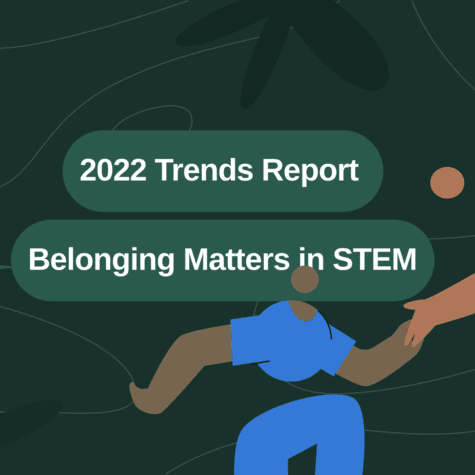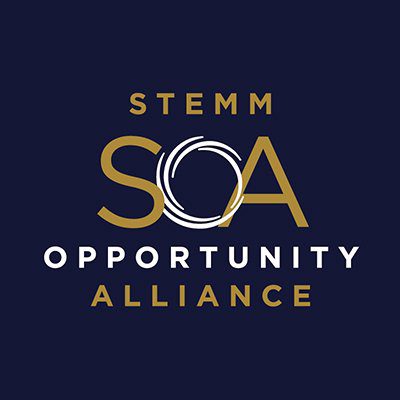Every year we spend countless hours learning from and talking to our partners, leading thinkers, advocates, teachers, and activists in STEM education, to better understand what their biggest bets and greatest challenges are and how they’re approaching them. We coordinate forums and listening sessions and pore over news articles, research, and national and regional data to identify the most salient and actionable information to share back with you. We’re excited and honored to share the 2023 Trends Report, which shares everything we’ve learned and highlights the most important insights and new ideas in STEM.
Belonging Is at the Root
In 2022, we refocused our efforts on addressing the deepest-rooted systemic challenges in STEM education. Guided by stories and insight from young people across the country, we heard that in order to help spark the brilliance of millions more young minds out there, we need to prioritize a focus on equity, representation, and especially belonging in STEM education. It’s a place where many of you have already centered your work, and we’re glad to be on the journey with you.
In the field and across the country, progressive initiatives are taking shape that are converging around the importance of belonging in STEM. This increased emphasis on fostering belonging is not only helping us better understand systemic challenges in education, but is also emerging as a powerful antidote to students and teachers disengaging from STEM. Throughout this report you’ll find that cultivating and nurturing belonging for students and aspiring and current teachers is at the foundation of many of the innovative approaches and strategies taking flight. We hope you’ll find these trends insightful, that you’ll share them with your friends and colleagues, and that the report creates opportunities for even more collaboration and exchange in 2023. That’s how we’ll move the needle to end the STEM teacher shortage once and for all.

This year, we’re inspired by dozens of new initiatives that go upstream of the shortage we’re facing, with increasing focus on attracting potential STEM teachers earlier and finding ways to open doors to more potential teachers with nontraditional backgrounds. We’re seeing a wave of new programs that aim to reach potential teachers earlier, creating opportunities for high school students to gain experience and training, and helping to expand career horizons in STEM teaching for more young people.

Beyond100K partners are behind some of these new programs, like Young People’s Project work to grow a teacher cadet program that will certify over 500 high school and college students as math literacy workers, building their interest and capacity for STEM teaching careers. Another partner, Encorps, expanded teacher recruitment practices through leading the Unconventional STEM Career Pathways project to provide even more support for career changes into STEM teaching with resources like a new teacher toolkit, a summer institute, and curricula that connect the dots between social justice and STEM to help attract more diverse teachers.

In order to grow and diversify our STEM teacher workforce, there’s a recognition of the need to increase the number of applicants to and participants in teacher preparation programs, and we’re seeing a trend focused on expansiveness to achieve that goal. In particular, we’re seeing programs that provide alternatives to traditional higher-ed pathways gaining traction, while we’re also seeing the growth of new types of alternative programs, such as apprenticeships, residencies, and community college pathways expanding across the country, as are fast-track education programs that make the transition into teaching possible for more people. Together, these programs are developing more accessible pipelines to STEM teaching, helping to create a more robust and diverse pool of prospective teachers.
Around the country and throughout the network, we’ve seen a variety of exciting new programs develop in this focus area. In Texas, UT Austin and Austin Community College are pairing up to lead a program called UTeach Access that will recruit students who applied to study biology, chemistry, math, or physics and offer them a spot in the UTeach STEM teaching preparation program. Reach University is offering job-embedded learning, where half a degree comes from on-the-job work and half comes from personalized online tutorials, creating greater access to teaching careers outside of traditional university-based programs. The National Center for Teacher Residencies’ (NCTR) is working to address this challenge at scale, providing technical assistance and support to develop and grow 14 teacher residency programs across the country, with a focus on supporting students from underserved districts to explore building a career in STEM education.

We’re reassured to see that new approaches appear focused on making STEM teacher preparation more accessible, rather than simply reducing the credential requirements for teachers. We’re hopeful that this trend signals a shift away from short-term emergency responses, and instead is a predictor of growing focus on innovative programs aimed at sustainable long-term change to create greater access to STEM teaching careers.

Throughout 2022, we heard from numerous partners that there is needed and increased attention on addressing issues of diversity, equity, inclusion, and belonging (DEIB) in STEM education, and a growing demand for frameworks, tools, and metrics that can help implement and assess their efforts. Teachers and administrators emphasized that greater clarity and understanding of DEIB issues across the field would not only help them launch new initiatives, but would also help leaders learn from each other, and develop common approaches and accountability systems to make progress on this crucial goal.
We’ve seen partners and others in the field experimenting with new tools to bring energy and solutions to this issue. On issues of belonging, a University of Michigan researcher developed a framework to help teachers foster student belonging in math and a University of Texas chemistry professor developed a simple and intuitive way to foster belonging among his students. For metrics, longstanding leaders like Partnerships in Education and Resilience (PEAR) continue their decades of work supporting teachers to use assessment tools connected to equity and belonging. The Education Trust developed a state-by-state dashboard focused on teacher diversity and National Academies will be publishing a consensus study on equity in K-12 STEM education in the spring.

We’re also seeing efforts guided by listening to BIPOC young people to inform DEIB initiatives to address equity in STEM education. Equal Opportunity Schools made a commitment to surveying over 250,000 historically underrepresented students of color from over 500 schools to inform action-oriented plans and to support DEIB learning for both teachers and administrators.

There is a legacy of exclusion impacting who we see and don’t see today in teaching positions that we need to acknowledge. While Brown v. Board of Ed was a landmark decision for equality, the aftermath led to many teachers of color have being marginalized and discriminated against, further contributing to generational inequities for students and teachers of color. Recognition of our history matters, and so does committing to increasing our focus on recruiting, preparing, and retaining BIPOC STEM teachers.
Our network is taking action, looking for new ways to increase and support teachers of color in their programs. The Diversifying the STEM Teacher Pipeline team began in 2019 to explore recruitment and pre-service support strategies for teachers of color, and has recently created a public website and hosted a virtual conference for organizations committed to the recruitment, preparation, and retention of teachers of color. Another project team created a toolkit focused on specific recommendations for administrators to improve work environments for teachers of color. We are also excited to see recent federal funding given to support HBCUs to scale up teacher residency programs, and we are encouraged to see that the U.S. Department of Education is giving $25 million to boost diverse teacher education across colleges and universities.

While we continue to work on persistent obstacles to retaining teachers of color that have disproportionate impacts on Black and Latinx teachers, we are also inspired by new learnings that help us understand how fostering belonging can address these systemic challenges. Through listening sessions, deep research, and conversations with experts, we heard that to truly have a more racially diverse teacher workforce, we need to recruit and retain more teachers of color, which we can only do if we promote positive work environments that center on belonging for teachers of color. We’re seeing belonging as a keystone for DEIB in STEM, and we expect to see even more activity around this in 2023.

We know that there is growing interest from educators across the country in fostering belonging to increase engagement and persistence in STEM for students and teachers alike. In December, the US Department of Education launched, YOU Belong in STEM, the first national STEM initiative in over 10 years grounded in the belief that creating the conditions for STEM excellence starts with students and teachers feeling a sense of belonging in the classroom.
During our own reflection work as part of the Beyond100K unCommission, 94% of participants shared stories of belonging and/or non-belonging connected to STEM education, and we saw a positive correlation between feeling a sense of belonging and a desire to pursue a STEM career. Their stories shaped our new strategic vision, and around the country, we are seeing this reflected in how the field is providing support and professional development to foster belonging amongst STEM teachers, while also developing new curricular materials and resources to help teachers foster belonging for their students as well.

Beyond100K partners are leading this work. LabXchange is developing new curricula as part of the Racial Diversity, Equity, and Inclusion in Science Education project, which will support educators with evidence-based teaching practices to foster students’ sense of belonging, identity, self-efficacy, and confidence in science, and another partner, Reconstruction is providing culturally relevant curricular content to over 10,000 classrooms that will support teachers of color to feel a greater sense of belonging in STEM, and foster the same sense of belonging, particularly for Black students. We’re also seeing work that bridges the gap between fostering belonging among teachers and students. The American Federation of Teachers has committed to training 1500 educators from 20 local partnerships to develop skills and mindsets that foster a sense of belonging in STEM classrooms, and Techbridge Girls has committed to delivering STEM Equity training and curriculum that centers teacher and student belonging to at least 100 educators from marginalized communities annually.
We believe we’re seeing an emerging trend as schools and districts increasingly acknowledge belonging as a critical component of STEM education that has the potential to impact recruitment, retention, diversity, and student learning. However, we know this is an uphill battle as we work to reverse the longstanding belief that STEM fields are only for the elite few who have what it takes to succeed. We’re hopeful that this culture shift will continue in 2023 and we’ll see belonging bloom across the STEM education world.



